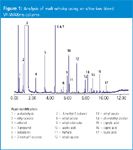Fast Analysis of Malt Whisky by GC–MS Using an Ultra High Performance VF-WAXms Column from Varian, Inc.
The Application Notebook
The flavours of malt whisky result from a complex blend of long chain esters and alcohols, derived from the distillation products and the composition of the wooden barrels in which the finished product is aged. As shown below, the new VF-WAXms column from Varian, Inc. is ideal for analysing whisky, especially when trace analysis is needed. The column's ultra-low bleed increases sensitivity, extends column life and improves accuracy, even at higher temperatures. In addition, VF-WAXms columns are suitable for use with MS detectors, as the ultra low bleed eliminates interferences and permits more sensitive detection.
John Oosdijk1 and Graham Farrell,2
1 Varian, Inc., Middelburg, The Netherlands,
2 Polymer Laboratories, now a part of Varian, Inc., Church Stretton, Shropshire, UK.
The flavours of malt whisky result from a complex blend of long chain esters and alcohols, derived from the distillation products and the composition of the wooden barrels in which the finished product is aged. As shown below, the new VF-WAXms column from Varian, Inc. is ideal for analysing whisky, especially when trace analysis is needed. The column's ultra-low bleed increases sensitivity, extends column life and improves accuracy, even at higher temperatures. In addition, VF-WAXms columns are suitable for use with MS detectors, as the ultra low bleed eliminates interferences and permits more sensitive detection.

Figure 1
VF-WAXms 0.15 mm i.d. columns have the added advantage of combining high resolution analysis with much faster run times, thus increasing productivity without the need to invest in new hardware. They can be used on all GC and detector combinations unlike other smaller i.d. types (e.g., 0.1 mm) that might require a hardware change. The 0.15 mm columns also have a greater loadability than 0.1 mm i.d. versions. VF-WAXms 0.15 mm i.d. columns, therefore, provide a perfect combination of productivity, high resolution, loadability and ease-of-use.
The value of the columns is clear in the analysis of malt whisky, where reduced column bleed in the 210–260 °C temperature range enables a more accurate detection and quantification of impurities in the whisky that elute close to the maximum temperature of the column. The presence of capric acid and other minor impurities, which elute at these higher temperatures, is revealed at lower concentration levels and with improved accuracy and analysis speed.
Sample: Single malt whisky
Column: VF-WAXms, 15 m × 0.15 mm × 0.15 μm
Technique: GC–MS (CP-3800 GC with 320MS)
Oven: 35 °C 3 min, 25 °C/min; 260 °C 10 min
Carrier gas: Helium, 2 mL/min
Injector: Split 1:20, T = 220 °C
Sample size: 1 μL
Detector: MS (EI), mz 21–350

Varian, Inc.
Postbus 8005, 4330 EA Middelburg, The Netherlands.
tel. +31 118 671 5000 fax +31 118 671 502
Website: www.varianinc.com

New Study Reviews Chromatography Methods for Flavonoid Analysis
April 21st 2025Flavonoids are widely used metabolites that carry out various functions in different industries, such as food and cosmetics. Detecting, separating, and quantifying them in fruit species can be a complicated process.
Analytical Challenges in Measuring Migration from Food Contact Materials
November 2nd 2015Food contact materials contain low molecular weight additives and processing aids which can migrate into foods leading to trace levels of contamination. Food safety is ensured through regulations, comprising compositional controls and migration limits, which present a significant analytical challenge to the food industry to ensure compliance and demonstrate due diligence. Of the various analytical approaches, LC-MS/MS has proved to be an essential tool in monitoring migration of target compounds into foods, and more sophisticated approaches such as LC-high resolution MS (Orbitrap) are being increasingly used for untargeted analysis to monitor non-intentionally added substances. This podcast will provide an overview to this area, illustrated with various applications showing current approaches being employed.

.png&w=3840&q=75)

.png&w=3840&q=75)



.png&w=3840&q=75)



.png&w=3840&q=75)







